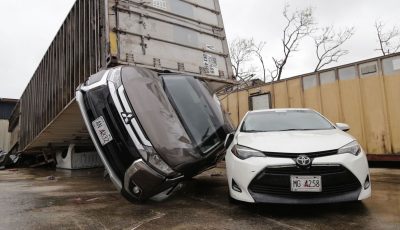No federal disaster aid for NMI
Damage from Vongfong totaled less than $500K
The damage on public infrastructure brought by Typhoon Vongfong last Oct. 6 failed to reach the $1-million threshold needed for the CNMI to qualify for Presidential Disaster Assistance, according to Homeland Security and Emergency Management special adviser Marvin Seman.
“We did not quality or meet the criteria for a presidential directive. It’s just not about the $1 million [threshold]. We looked at every possible avenue from the presidential directive from FEMA [Federal Emergency Management Agency] to SBA [Small Business Administration]. The threshold was $1 million, CNMI-wide. We didn’t reach $1 million in public disaster and thus the CNMI is not qualified for federal disaster aid,” he said in an interview with Saipan Tribune Wednesday.
Last week, Seman, along with acting governor Jude U. Hofschneider, Attorney General Gilbert Birnbrich, and acting press secretary Ivan Blanco, flew to Tinian and Rota to assess the damage caused by Typhoon Vongfong.
Using rough estimates, Seman said total damage from Vongfong in the CNMI didn’t even reach half a million dollars.
“Overall estimate on the figures that we have with [the Public School System] comes in at roughly $30,000 and the central government comes at $50,000 for the overall management of the disaster and coordinating with the municipalities of Tinian and Rota. The [cost in] utilities is another thing, but overall we didn’t even break $500,000.”
When asked which island took the brunt of the damage from the typhoon, Seman said it was surprisingly Saipan and not Rota, where the typhoon came closest.
“We assessed all three islands and in general Saipan appears to have sustained the most damage and that’s because of the population. Overall, if you look at it in context it would be the same, two or three houses damaged on Saipan, Tinian, and Rota and the crop damage.”
Seman also said while the seaplane ramp on Rota was indeed damaged, as reported earlier by Sen. Paul A. Manglona (Ind-Rota), it was not extensive enough to put the CNMI in the $1-million FEMA disaster threshold.
“Besides, that was mostly due to erosion,” Seman said of the damage to Rota’s seaplane ramp.
He said other damage they inspected last week appeared to have been caused by previous typhoons and storms, which further disqualifies the CNMI from federal assistance in the first place.
“The tricky thing with a presidential directive is it should be for that event. In the case of the CNMI we had Phanfone and Vongfong come by and various small storms that passed us by creating storm surge to the island. All those small storms don’t matter. It has to be that one particular one causing major damage.”
All in all, even if the CNMI will not be getting federal assistance, Seman said it was still a good exercise for all emergency agencies.
“We had an opportunity to talk to the FEMA office and as well as the SBA. We are actually grateful to both FEMA and SBA because they had individuals come down here. FEMA sent one ahead of the storm and that’s part of the protocol.”
Seman said HSEM also took a look at the SBA assistance but the CNMI again fell short of qualifying since the threshold for the program was for 25 damaged homes for the entire CNMI.
Crop damage assessment caused by Typhoon Vongfong was delegated to the Department of Land and Natural Resources and NMC-CREES.
Seman also thanked the American Red Cross-NMI Chapter and the Department of Community and Cultural Affairs for the help they’ve done for individuals and families who lost their homes in the wake of the typhoon.
He said Saipan is dealing with three who were rendered homeless because of Vongfong, while Tinian also has the same number. Those on Tinian have been brought in by other family members, while those on Saipan are currently staying at one of DCCA’s long-term shelters.
“The CNMI did pretty good in terms of preparing for the typhoon. We’ve gone through a lot of worse storms during the last 10 or 15 years or so. I would like to remind the community that we live in a typhoon-prone area. It’s also not the only thing that threatens us. We’ve had some seismic activity and earthquakes within the region that have shook the islands. It’s a wake-up call. We’re on the Marianas Trench and it’s a constantly moving plate along with the Philippines plate. We just need to be vigilant and understand the threat. This is what we call home but home has its ways.”



























